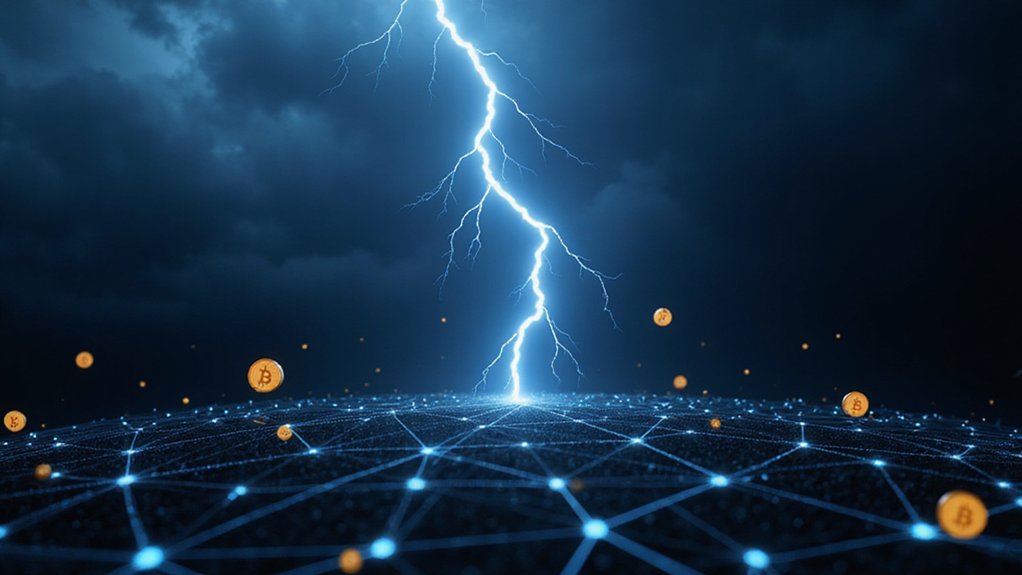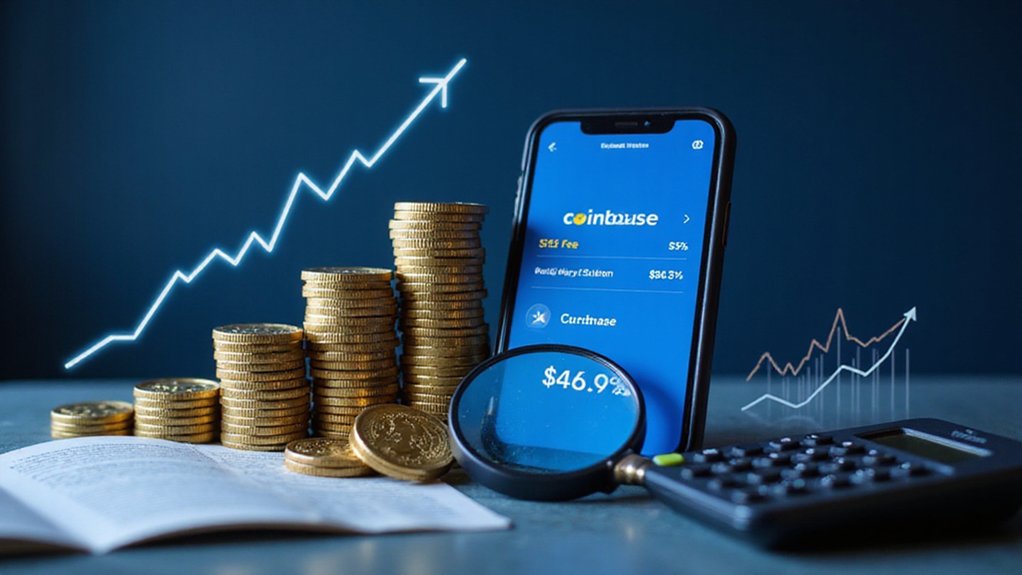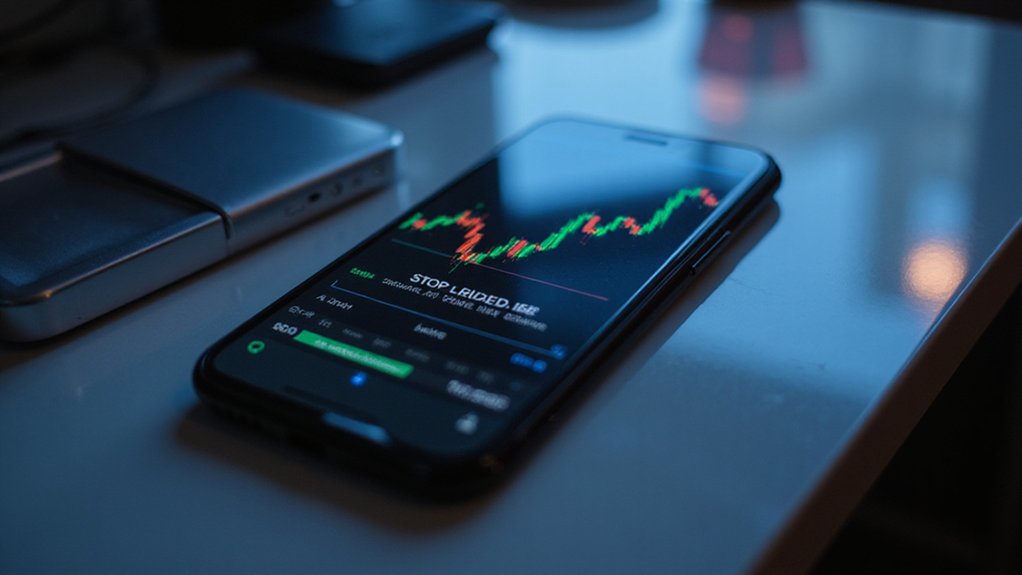The Lightning Network is Bitcoin’s second-layer protocol, designed to solve its scalability problem by enabling off-chain transactions. Developed in 2016, it creates a mesh of payment channels secured by hashed timelock contracts, allowing users to conduct unlimited transactions without touching the blockchain. This clever workaround transforms Bitcoin from a digital store of value into a potential everyday payment system—processing theoretically millions of transactions per second at fractional costs. The technical complexity masks an elegant solution to Bitcoin’s most persistent limitation.

The Lightning Network stands as Bitcoin‘s most significant leap toward solving the cryptocurrency’s inherent scalability limitations—a second-layer protocol that transforms Bitcoin from a digital gold equivalent into a potential competitor for everyday payment systems like Visa and Mastercard. Proposed in 2016 by Joseph Poon and Thaddeus Dryja, this open-source innovation creates a mesh of off-chain payment channels where users can conduct unlimited transactions without the burden of recording each one on Bitcoin’s congested blockchain.
The protocol’s elegant design uses hashed timelock contracts (HTLCs) to secure transactions across a web of interconnected channels, allowing Alice to pay Charlie without a direct connection—provided both share channels with Bob, who serves as an intermediary node. This routing capability (though occasionally hampered by liquidity constraints) enables theoretically millions of transactions per second, dwarfing Bitcoin’s modest seven TPS capacity and even challenging traditional payment rails. These channels function as essential micropayment mechanisms between parties for facilitating transactions. The system utilizes onion routing for payments that must travel through network intermediaries when direct channels aren’t available.
What’s particularly remarkable about Lightning isn’t merely its technical sophistication but its real-world adoption trajectory. When El Salvador made Bitcoin legal tender in 2021, the government didn’t rely on standard on-chain transactions (which would have proven prohibitively expensive for everyday purchases); instead, they deployed Lightning-enabled wallets. Similarly, Twitter‘s integration with Strike allowed users to send Bitcoin tips with fees measured in fractions of a cent rather than dollars.
The network isn’t without challenges—routing complexities, security vulnerabilities in early implementations, and centralization pressures remain significant hurdles. User experience issues persist for non-custodial setups, creating a technical barrier that custodial solutions like Paxful attempt to mitigate for their 1.5 million African users.
As Lightning’s capacity—exceeding 5,400 BTC at its peak—continues to grow, its potential extends beyond simple payments to enabling atomic swaps, streaming micropayments, and possibly even serving as infrastructure for central bank digital currencies. The innovation represents not just a technical fix but a fundamental reconsideration of what Bitcoin can become.
Frequently Asked Questions
How Secure Is the Lightning Network Compared to Traditional Bitcoin Transactions?
The Lightning Network trades Bitcoin’s robust blockchain security for transactional efficiency, operating with a different security model altogether.
While Bitcoin transactions benefit from immutable, consensus-verified permanence, Lightning’s security hinges on properly maintained payment channels—functional yet theoretically more vulnerable to certain attack vectors.
Channel breaches trigger penalty mechanisms (ingeniously disincentivizing malfeasance), while privacy features like onion routing actually exceed Bitcoin’s native capabilities.
The choice between them isn’t about “better” security but rather appropriate security for specific use cases.
What Are Common Criticisms of the Lightning Network?
Common criticisms of the Lightning Network revolve around transaction costs (channel opening/closing fees may offset savings), reliability issues (nodes must remain continuously online), and scalability limitations (microscopic Bitcoin supply availability on Lightning).
Additionally, the network faces security vulnerabilities (exposed by replacement cycling attacks), user experience challenges (counterintuitive fund reception mechanics), and concerning developer exodus (original authors abandoning the project).
These factors collectively raise questions about its viability as Bitcoin’s primary scaling solution.
Can Lightning Network Payments Be Traced?
Lightning Network payments are inherently difficult to trace due to their encrypted nature and use of onion routing.
Unlike Bitcoin’s transparent blockchain, Lightning transactions remain off-chain until channels close.
Each routing node only sees adjacent hops in the payment path—never the complete route.
While sophisticated network analysis might reveal patterns, the combination of HTLCs, encrypted invoices, and the network’s decentralized structure creates formidable privacy barriers that would confound even the most determined blockchain sleuth.
Which Major Companies Currently Support Lightning Network Payments?
Several corporate giants have embraced Lightning Network technology, recognizing its disruptive potential in payment processing.
OpenNode specializes in Bitcoin Lightning payments, while Coinbase—a cryptocurrency behemoth—recently integrated the protocol.
Strike, perhaps the most prominent Lightning-focused company, has secured partnerships with Shopify and NCR, extending the network’s reach into mainstream commerce.
Cash App’s integration has exposed over 70 million users to Lightning functionality—a remarkable distribution channel for what was once considered fringe financial technology.
What Happens to Lightning Channels During a Bitcoin Hard Fork?
During a Bitcoin hard fork, Lightning Network channels face an existential choice: close or commit.
Since these channels are anchored to the main chain, they must eventually settle on one blockchain variant or risk losing funds.
Operators typically need to close existing channels before the fork and reestablish them afterward on their preferred chain—a process requiring coordination, updated node software, and potentially significant transaction fees during the inevitable pre-fork congestion (when everyone rushes to secure their positions).









